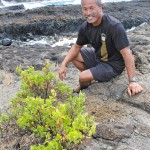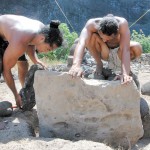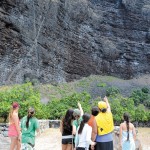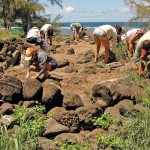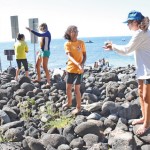Na Pali Pals
Na Pali Coast Ohana volunteers share a mutual love and sense of stewardship for the aina.
“I think it’s very natural in human nature when you love something, you want to take care of it,” says Kelvin Ho, the organization’s vice president.
- Kelvin Ho and other members of Na Pali Coast Ohana take their relationship with Kauai’s famed Na Pali Coast personally, removing invasive species, allowing native plants to flourish, and returning both a cultural and spiritual sense to the beautiful and ancient shoreline. Coco Zickos photo
- Na Pali Coast Ohana volunteers work to restore one of the many sacred sites in the coastal region
- X literally marks the sacred spot at Nualolo
- Volunteers plant native species along Na Pali Coast. PHOTOS COURTESY KATHLEEN HO
- Kelvin Ho, board vice president of Na Pali Coast Ohana. COCO ZICKOS PHOTO
- Students help with the restoration of Na Pali Coast
Ho has had a particular fondness for Na Pali Coast since he began recreationally exploring the region in 1979. At the time, before Na Pali Coast Ohana began restoration, the area was entirely overgrown with weeds.
“It was uncared for and had been left for a long time,” recalls Ho.
Since joining forces more than 20 years ago, Na Pali Coast Ohana volunteers such as Ho have helped to dramatically improve the condition of the majestic coastal area, restored sacred sites and given native plants a chance to flourish again.
Nualolo, where ancient civilizations from Na Pali once gathered, is one of the areas on which the group has focused in recent years. Volunteers have eradicated enormous amounts of invasive species, allowing archaeologists and cartographers greater access to the valley for research purposes. Several native species also have been replanted, many of which now are surrounded by a fence to protect them from ungulates, primarily goats. The plants are unique in that they are watered by a well, which comes from one of Hawaii’s most rare heiau complexes – a site where volcanic rock makes a literal “X” to mark the spot. Now, a trail allows visitors access to these restored wonders of Nualolo, including a halau waa (canoe house), which wouldn’t have been possible without the ohana’s years of dedicated work.
“For me, it’s really important, as far as the education component is concerned, to bring youth groups there to learn values as well as the culture, and doing it in a place that’s so connected,” says Ho.
Inspiring keki to feel a connection to sites such as Nualolo is of utmost importance to Ho.
“Na Pali Coast is an extremely sacred and storied place,” he says.
During the summer months, the group brings at-risk youths by boat to places such as Nualolo and Milolii, where a tremendous amount of rehabilitation has been completed. What makes the experience so special is that even though some of the keiki have grown up on Kauai, they’d never had the opportunity to visit Na Pali Coast.
“We need to be the links between the youths, because they are our future,” says Ho.
Though many children may not have visited Na Pali, it has become quite a prominent visitor destination, and the region is gaining an incredible amount of attention and traffic with little, if any, cultural connection.
“Not because people don’t want it or feel it, but because they don’t have a sense of the sacred,” says Ho, who wants to help bring that essence back into the area. “It’s about keeping a sense of reverence and sacredness about this place that’s really been loved, cared for and nurtured by people who once lived there sustainably.”
Thousands of Hawaiians are believed to have once resided in Kalalau alone, and archeologists have discovered an abundance of iwi in each of the valleys. Because of Na Pali Coast Ohana’s commitment in honoring the sacred, many of these bones, originally removed for scientific purposes, have been returned.
“As the consciousness shifted, a lot of museums awoke to the sensitivity and realization of how horrific it is to take bones,” says Ho.
This summer, in fact, another set of remains is scheduled to be returned, and the ohana has grown to the point now where cultural practitioners are capable of creating kapa for reinterment from wauke propagated in Nualolo.
“It’s really an indicator of how far and how much progress they’ve made,” says Ho, who has been a volunteer with the organization for more than a decade.
One of the nonprofit’s greatest achievements was its ceremony hosting Hokulea’s first overnight stay in Na Pali at Nualolo. The event was a true testament to hard work of the volunteers, who spent so much time restoring the area to its original splendor.
“It’s great to just pour your sweat and blood and just give to the land,” says Ho.
Visit napali.org for more information.
cocomidweek@gmail.com

